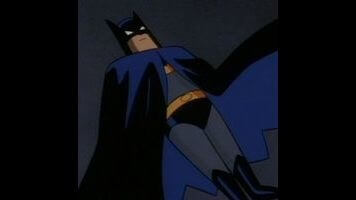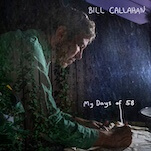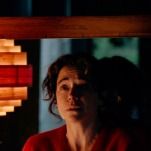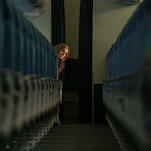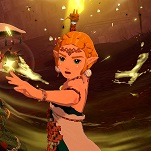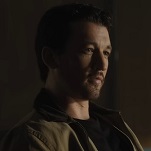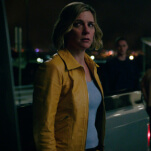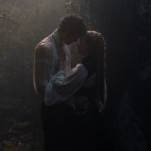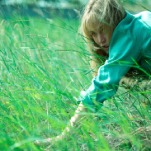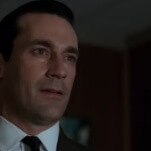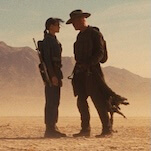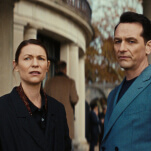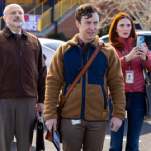“House & Garden” (season 2, episode 5; originally aired 5/2/1994)
Wealthy bachelors are being poisoned and robbed across Gotham City, but Batman’s main suspect appears to have turned a new leaf. Poison Ivy has been one of Batman: The Animated Series’ most reliable rogues for entertaining episodes, and “House & Garden” is her best, a tragic horror story penned by Ivy aficionado Paul Dini. Dini’s greatest strength is in exploring the metaphors underneath the rogues’ gimmicks, and he approaches Poison Ivy from a different angle than her previous femme fatale appearances. Reformed and happily married with a house in the suburbs and her husband’s two sons, Pamela Isley has given up on her villainous career, finally finding happiness through the traditional family model.
In the past, Poison Ivy’s thematic connection to the plant world manifested in her beautiful but deadly personality; like a poisonous flower, Ivy’s appearance masks her true menace. That camouflage is still in full effect in “House & Garden,” but Dini adds a new dimension to Isley with her newfound desire to have a family. Because of her hyper-immune system, she’s unable to have children, so she hatches an elaborate, disturbing plan to make a family on her own terms.
When Batman and Commissioner Gordon visit Pamela’s suburban home, she explains her motivation behind her new lifestyle: “I guess there really does come a time when a woman wants something more in her life. At least this woman does.” Paul Dini humanizes the rogues by giving them something they genuinely care about, and as one of Batman’s few female villains, Poison Ivy gives Dini the opportunity to explore the effects of infertility on a woman’s psyche. Despite being filtered through a children’s superhero cartoon, the emotional impact of the story is surprisingly strong, with an especially tragic ending that echoes Killer Croc’s helicopter ride at the end of “Sideshow.”
Like Croc, Poison Ivy can’t escape her true nature. She seizes the opportunity to take control of criminal profiler Steven Carlyle, seducing him with her poison kiss, then keeping him in a tank while she uses his DNA to create plant duplicates. These duplicates rapidly grow, playing the part of Steven’s sons at birth, then filling in for Steven himself before transforming into the developmentally challenged Hulks that Ivy uses to steal money. Even when she tries to be a different person, the only way Ivy can support her life as a loving wife and mother is by poisoning and robbing men to gain money for her mad-science lab.
This episode marks Robin’s first appearance in the second season, and while he doesn’t do much except get held for ransom, we get a strong sense of his character in his brief appearance. The scene with Cindy (voiced by a pre-Will & Grace Megan Mullally) in Dick’s dorm room shows a womanizing Dick Grayson that acts a lot like the person Bruce Wayne pretends to be in public. The difference is that Dick isn’t pretending—he’s actually horny. A Bat-cock block puts an end to the potential make-out session, but Dick continues to show off his free spirit throughout the episode. One of my favorite bits is when he backflips off of the Carlyle’s house, showing off some of those circus skills because why the hell not?
Dini and director Boyd Kirkland whip out the usual horror tricks to build suspense, and they work wonderfully. The plant monster is kept out of sight for most of the episode, there’s an attack from the backseat of Bruce’s car (always check the backseat), a hand reaches out from a pool of water, and creepy kids emerge out of pods and call for mama. Kirkland’s pacing for the final act is perfect, beginning with the discovery of Ivy’s underground lab and leading up to the big reveal of her nursery of literal cabbage-patch kids. It’s incredible that Paul Dini was able to get away with a story this dark, and Kirkland takes advantage of a great script to create some intense sequences.
Shirley Walker composed the music for this episode, and she created a beautiful score that always works to heighten the events on screen. As Batman watches Pamela’s daily movements from afar, strings are layered on top of horns to create a wonderfully foreboding variation of Batman’s theme. When Pamela arrives at her greenhouse, the theme fades out and a light string melody begins, strengthening the illusion of her reformation through music. The horror of the episode would be much less effective without Walker’s Bernard Herrmann-influenced score, and it’s essential in capturing the suspense of the story’s chilling conclusion.
Stray observations:
- Batman Beatdown: After getting knocked off the pier by the plant-Hulk, Bruce swims to his Bat-Jet Ski (Batski?), changes into his costume, and flies the Jet Ski directly into the monster for some vehicular herbicide.
- The video commentary for this episode is horrifically awkward. Whoever thought it was a good idea to record Bruce Timm, Dini, and Kirkland on camera with a mediator that asks all the wrong questions needs to be committed to Arkham. A lot of time is spent talking about Commissioner Gordon’s cowlick and digital editing when they should be talking about the crazy story.
- The back-up story in Batman Adventures Vol. 2 #16 reveals that after “House & Garden,” Pamela Isley went into deep hiding in the Louisiana bayou with Alec Holland (a.k.a. Swamp Thing). The revamp Poison Ivy is really just another duplicate that Pamela left to keep Harley company and Batman off her trail. Man, Batman Adventures was awesome.
- Batman uncharacteristically spends a lot of time in the daylight this episode. Yes, stealth is hard in the suburbs, but he could do better than parking the Batmobile on the street.
- In case you missed it, The A.V. Club reviewed Justice League: Doom last week.
- Dick: “I just thought it would be fun to get together and study and talk and um… ” Cindy: “And?” Flirty Robin is adorable.
- Pamela: “Batman? Good luck.” Batman: “You too, Mrs. Carlyle.” A great moment of respect between two adversaries that reveals how conniving Poison Ivy can be.
